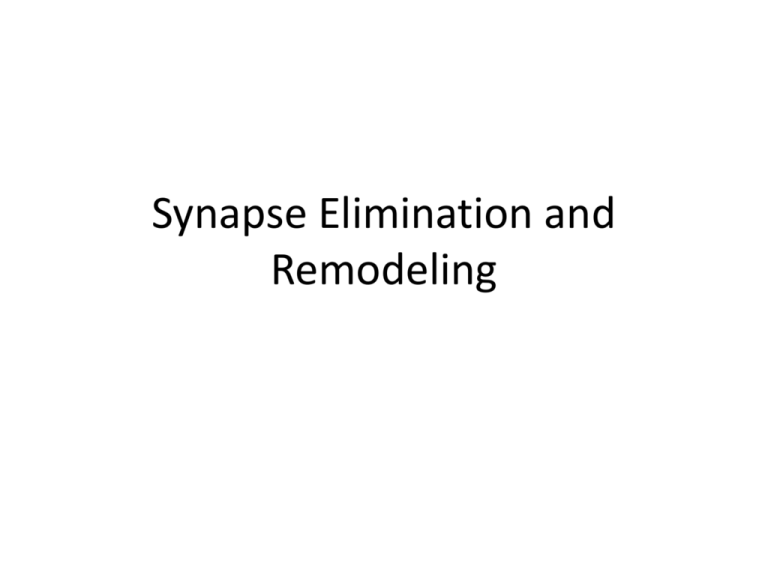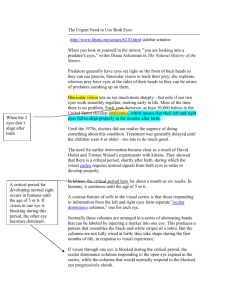Synapse Elimination and Remodeling
advertisement

Synapse Elimination and
Remodeling
• An extremely protracted developmental process –
starts after birth and continues throughout life.
• Synapse elimination is an important component of
development, as many more synapses are formed than
would be present in the adult animal.
• Most often, these changes are related to adjustments
in the number and strength of synaptic connections
(“fine-tuning”), as opposed to simply pruning.
• E.g., in vertebrates, this process occurs in situations
where there is a need to partition info among
homogeneous populations of target cells.
• I.e., Thousands of identical muscle fibers, each
innervated by 1 NMJ in adult (initially contacted by
several) decr degree of convergence.
• The functional rationale for this fine tuning: muscle
contraction (‘twitch’) is ‘all-or-none’ – multiple inputs
in various parts of the cell would not be beneficial.
Synapse Elimination
The total number of synapses on ganglion cells in the rat submandibular ganglion
increases during early postnatal life.
Innervation of individual neuromuscular junctions (ovals on
muscle fibers) by axonal branch trimming.
Over the first several weeks of
postnatal life, rodent motor
axons remove branches
each neuromuscular junction
undergoes a transition from
innervation by multiple
converging axons to innervation
by only one axon.
The number of muscle fibers
innervated by an axon decreases
substantially 9axonal
convergence decreases) and all
but one input is eliminated from
each fiber.
This occurs by branch removal
rather than motor neuron death.
Neuromuscular Synapses are Eliminated
During Postnatal Development
At birth, nearly all muscle fibers are
polyneuronally innervated.
During the next two weeks, all
but one of these synaptic
inputs is lost.
Neuromuscular Synapses Compete for
Survival
Synchronous electrical activity accelerates elimination, synchronous paralysis delays it.
• Application of
excesses of different
neurotrophic
molecules prolongs
polyneuronal
innervation
• Several pathways
may exist that help
mediate competition
• Nature of
competition may be
more like a judged
contest than like a
race.
Synapse Elimination in both
Development and Regeneration takes
much time
Neuromuscular Synapse Elimination is
Gradual and Asynchronous
Multiple Innervation
Terminal Segregation
Branch Withdrawal
Axon Retraction
Keller-Peck et al, Neuron 31: 381-394, 2001
• Any competition between inputs is resolved
at the level of individual synapses
Time-lapse imaging of synapse
elimination.
Two neuromuscular junctions (NMJ1 and NMJ2)
in vivo on postnatal days 7, 8, and 9 in a
transgenic mouse that expresses YFP in its
motor axons.
The acetylcholine receptors at the muscle fiber
membrane are labeled red with rhodamine
tagged α–bungarotoxin in each muscle fiber.
The transition from multiple to single
innervation of NMJ1 as one axon, a sibling
branch of the axon that innervates NMJ2,
undergoes atrophy and appears to retract. The
eliminated branch terminates in a "retraction
bulb." Modified from Keller-Peck et al. (2001).
Decreased
Convergence and
Divergence
During Development
and Regeneration:
Devel.
Regen.
Convergence and Divergence
• The rationale for starting with many is not as
clear (much energy goes into making as many
only to have them torn down).
• What idea might you have? Propose a rationale.
• Divergence also exists early in development; 1
neuron many different targets, which are
decreased by synaptic elimination processes.
• In muscle, this scenario of decr convergence and
divergence is re-captured when re-innervation
occurs after injury.
Synapse Elimination Involves Synaptic
Takeover
• The surviving input takes over the synaptic space formerly occupied by the losing
input(s). Walsh & Lichtman, Neuron 37: 67-73, 2003
Synapse Elimination is a Balance of
Anterograde and Retrograde Signals
Proposed Functions of Synapse Elimination
1.
Provides a way to ensure that each muscle fiber is innervated.
2.
Allows axons of different motoneurons to capture a number of cells appropriate
to its size.
3.
Provides a means by which normal function can change the strength of synaptic
connections.
Gatesy & English, Dev. Dyn. 196: 174-182, 1993
• Adult muscles are partitioned into neuromuscular compartments – exclusive innervation territories.
• In the absence of competition, cross compartmental inputs will form in neonates but not adults
• Synapse elimination completes the specific innervation of neuromuscular compartments
• Synapse elimination may not be leading to decreased
numbers for a particular site.
• E.g., redistribution of synapses to increase strength at
same sites (more release sites).
• Remember from earlier courses what is synaptic
strength?
weaker (diffuse) stronger (more focused on
individual cells.
1. Some degree of synapse elim comes from cell death
(discussed in the PCD slides).
2. Synapse elim involves the physical withdrawal of the
nerve ending. It gradually takes on a ‘bulb’
morphology – the opposite of a growth cone?
Retraction bulb
Anatomy of the Visual System
Both eyes project to each visual cortex, but at the primary visual area (17), they
remain largely segregated into ocular dominance columns.
Synapse Elim/Refinement in the
Developing Visual System
A highly examined system to study synapse elim
and refinement.
Layer IV of the visual cortex (VC) segregation of
neuronal inputs.
In young animals, neurons within this layer (IV) can
be activated by inputs driven by both the L and R
eye some inputs withdrawn so that some are
strongly dominated by R eyes and others by L
eyes.
Inputs form a striking pattern of alternating stripes,
known as ocular dominance columns.
Ocular dominance columns
Ocular Dominance Columns are
Organized After Birth
This synaptic rearrangement is brought
about by axon retraction and local
outgrowth of geniculate neurons.
The development of ocular dominance columns
LeVay S, Stryker MP, Shatz CJ,
1978;
At 2 weeks, there is a continuous band of synaptic connections in layer IV that represent
the input to the visual cortex from geniculocortical afferents. At 6 weeks, fluctuations in
the intensity are already apparent. By 13 weeks, the pattern of cortical striping is similar
to that seen in the adult. The segregation of synaptic inputs within the cortical layer
depends on synaptic activity from postnatal visual experiences.
Normal binocular input
Synapse Elim/Refinement in the
Developing Visual System
Elim restructures the neuronal population that
serves each eye; Addition strengthens the
connections that remain.
Spatial patterning of connectivity by synapse elimination in the
visual cortex
Axonal projections from each eye are organized into separate eye-specific layers in the dorsal lateral
geniculate nucleus (dLGN). The axonal terminals of dLGN neurons in each eye-specific layer terminate
and occupy adjacent territories in layer IV, forming ocular dominance columns in the primary visual
cortex.
Organized pathways representing the left and right eyes are separated spatially and functionally from
the retina to layer IV emerge during development from less precise patterns of connectivity. Both dLGN
neurons and layer IV cells initially receive converging eye input. Inputs segregate first in the dLGN and
then in the cortex.
• One purpose of synapse elim in vertebrates is
to refine retinotectal maps, which form in the
visual cortex, LGN, and superior colliculus.
• As noted before, this refinement can occur
through cell death or axonal arbor withdrawal.
Effect of chronic closure of one eye on the responsiveness of
visual cortical neurons to input from each eye.
A) Ocular dominance distribution in V1 of 3 to 4 week old kittens. Cells in group 1 are driven only by
the contralateral eye; group 2, contralateral eye is markedly dominant; group 3, contralateral eye is
slightly dominant; group 4, no apparent difference in the drive from two eyes; group 5, ipsilateral eye
dominates slightly; group 6, dominated markedly; group 7, cells are driven only by ipsilateral eye.
B) Ocular dominance distribution was altered dramatically in a kitten exposed to contralateral eye
closure for 1 week from 23 to 29 days of age.
C) Ocular dominance distribution was essentially normal in an adult cat exposed to contralateral eye
closure for 26 months. From Hubel and Wiesel (1970).
Some Observations in the Visual System
• 1 eye closed columns “dominated” by input
from the other eye.
• Evidence that this was based on neuronal activity
level and not just visual input per se:
Spontaneous activity is silenced by tetrodotoxin
competition actually shifts toward the sutured
eye {note: some column formation occurs before birth}.
[also shown when postsynaptic activities are
inhibited by GABA].
Therefore, active input and postsynaptic responses
are required.
After closure of one eye
Effects of Neonatal Monocular
Deprivation
Normally, most cells receive
visual inputs from both eyes,
but not equally
After MD as neonates, very
few cells receive inputs from
the closed eye
Many cells in visual cortex remain responsive to inputs from both eyes after binocular
deprivation.
•Development of proper circuitry depends on proper balance of inputs from two eyes
Monocular deprivation in adult has no effect
Effects of Monocular Deprivation Are
Noted Anatomically
• Sensory deprivation early in life can alter the structure of the cerebral cortex.
Rudimentary Ocular Dominance Columns
Develop in the Absence of Visual Inputs
• Columns in layer 4a of primary visual cortex
with appropriate eye-specific inputs are
present before the critical period for ocular
dominance column plasticitiy.
•Columns develop in the absence of visual
system input and before the development of
retinal photoreceptors.
• Columns are not altered by visual
deprivation.
Cowley & Katz, Curr. Opin. Neurobiol. 12: 104-109, 2002
• Full development of columns occurs later,
and can be seen as a refinement of these
primitive columns.
Differences from earlier studies is thought to be a matter of technique.
Decreased
Convergence and
Divergence
During Development
and Regeneration:
Devel.
Regen.
Convergence and Divergence
• The rationale for starting with many is not as
clear (much energy goes into making as many
only to have them torn down).
• What idea might you have? Propose a rationale.
• Divergence also exists early in development; 1
neuron many different targets, which are
decreased by synaptic elimination processes.
• In muscle, this scenario of decr convergence and
divergence is re-captured when re-innervation
occurs after injury.
What Leads to the Segregation of These
Competing Inputs?
• The physiological wave pattern of activity from each
eye would be synchronous
Inputs would tend to segregate into synchronous regions
(strength would determine final density of each
region).
The presence or absence of trophic factors also appears
to influence the state of ocular dominance columns.
This plasticity (ability for synapses to re-arrange) is only
present during a critical period of development
because the segregation of synchronous connections
and competition can no longer occur (after this critical
period).
Segregation of axonal input
Synchronous Activity From Each Eye
Organizes the Ocular Dominance Columns
Blocking activity in both eyes with TTx or synchronous stimulation of both optic
nerves block formation of ocular dominance columns.
• Asynchronous activity leads to formation of ocular dominance columns.
• Normal development depends on competition for acquisition of synaptic
partners
This competition is emphasized in
three-eyed frogs.
Competition determines which Axon will
be Retained
• In studies, synapses have been observed over
time post-denervation (observe the reinnervation process).
• Changes often occurred post-synaptically (i.e. loss
or re-arrangement of Ach receptors) before
terminal withdrawal.
• This occurs in development as well: 1st sign of
synapse loss at a site is decr AchR density.
• This may explain earlier synaptic weaknesses
before process is complete.
NMDA Receptors Mediate
Competition
Cooperative activity of
afferent neurons from one
eye are thought to
depolarize target neurons
sufficiently to release Mg
block of NMDA receptor,
allowing Ca influx.
NMDA receptor acts as a
coincidence detector of the
activity of neurons from a
single source.
They support one aspect of
the theory of learning
proposed by Hebb.
An additional retrograde signal to the presynaptic neuron is required.
Competition determines which Axon will
be Retained
• What is the nature of the competition? I.e., what
are the axons competing for?
1. Trophic factor from targets (for maintenance)?
2. Competition is indirect and postsynaptic
membrane (e.g., muscle) does the “choosing”
and gives a retrograde “message”.
Evidence indicates that this message comes from
(or results from) the prior loss of receptors or
other post-synaptic proteins (e.g., rapsyn).
What Determines which Receptor Groups
will Diminish?
• One possibility is the type and degree of
activity.
• All these neuronal endings interact (retained
and lost) – this could be 1 way to distinguish.
• Synchronous activity could be somehow
protective for the receptors, whereas strong,
synchronous activity could be destabilizing.
What Drives the Competition between
Axonal Endings for Target Space?
• Neuronal activity level.
• Activity-driven neuronal connections is
applicable to several situations during
neuronal development and throughout life.
Activity-mediated
signals
Presynaptic Activity May Enhance Release of
Neurotrophins From Target Neurons
Neurotrophins could form such a retrograde signal.
NGF
trkA
BDNF
NT-4
trkB
NT-3
trkC
p75NTR
NO, another retrograde
signaling molecule is not
required for formation of
ocular dominance
columns.
Finney & Shatz, J. Neurosci.18: 8826-8838, 1998
Excess of trk B ligands removes the ability
of NMDA receptors to mediate
competition.
Model of Synaptic Rearrangements





